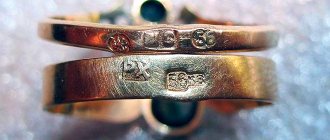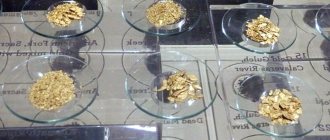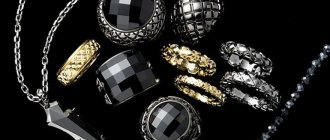Materials such as green gold are increasingly being used to make jewelry. It is an alloy of the usual yellow metal with silver, sometimes diluted with a small amount of copper and other components to obtain different shades.
Such gold is used both for the manufacture of entire jewelry and as a material for decorative inserts in them.
Origin of green gold
Green gold became known several thousand years ago. For example, the ancient civilization that lived on the island of Crete used this material to make jewelry, various items for religious rituals, as well as for everyday purposes.
When this ore was discovered several thousand years ago, people called it electrum. This is an alloy of different metals: gold, silver; the percentage of gold in the alloy could be no more than 40%.
In ancient Lydia, such gold was very popular. One of the rulers of this people used electrum to mint coins that had a specific greenish color. If we talk about the time frame, then this is approximately the 6th century BC. e.
Later, the technology for producing green gold in unnatural conditions was lost. Scientists came up with the idea of reviving the green alloy back in the 19th century. Since that time, many variations of this precious alloy have been created, differing in the admixture of various metals.
Jewelry requirements
Processing green gold requires high-level craftsmanship, patient work, knowledge and experience from the jeweler. That is why jewelers have certain requirements for this capricious alloy.
First of all, the metal must be passive to chemical reactions with air and other substances that are easily accessible to the average person in everyday life. For example, gold in combination with rubidium or cadmium has a negative impact on human health and can even leave a chemical burn on the skin.
Green metal must have sufficient ductility and resistance to mechanical stress. Otherwise, the jewelry will turn out to be very short-lived. The alloy must also have sufficient hardness to successfully undergo jewelry processing.
Very rarely, jewelers can use nickel as a ligature to obtain a precious green alloy. This metal simultaneously gives gold the strength needed for processing and a grassy tone. But when wearing such jewelry every day, there is a small percentage of the likelihood of allergic reactions.
What is green gold?
Green gold is an alloy of 750 and 585 gold with an admixture of various components, for example, cadmium. It is the inclusion of cadmium that gives green gold jewelry its unique, rich green color. But it is precisely this alloy that will be toxic. Cadmium causes severe allergic reactions and is prohibited for use in jewelry in Eurozone countries.
In the Russian Federation, a ban on the use of cadmium was issued in 2000; in other countries, such as Guatemala, this substance is officially permitted and can be added to green gold.
When inhaling cadmium fumes, a person may stop breathing, and there is a very real threat of death. For this reason, using cadmium in the jewelry making process itself is very dangerous. And if you wear it constantly, it can accumulate in the body.
Use of metal
Jewelers use this material to make a wide variety of jewelry: rings, bracelets, pendants, earrings, brooches, clips, hair accessories, cufflinks, necklaces and chains.
18k green gold is also used as the basis for souvenirs, awards, orders, corporate badges and enamel products. Unlike many other types of colored gold, it can be used as a base for jewelry. Jewelry made from this unusual alloy looks very exotic and seems to glow with a soft greenish light.
Unfortunately, only dull versions of electrum can be used to create an entire ring or bracelet. Mixtures with a deep green tint are usually too brittle or toxic to be useful. Nevertheless, inserts, overlays and individual elements of jewelry are sometimes made from them.
The combination of several types of green gold with each other, as well as their combination with other alloys and intermetallic compounds of different shades, looks very beautiful. The contrast between the two metals makes the jewelry unusual, and the harmonious combination of colors gives it tenderness. At the same time, a product made of such gold will almost never look too bright or vulgar, unlike classic yellow jewelry, which is quite easy to “overload”.
The noble green metal also goes well with many precious, semi-precious and decorative stones: from emeralds and sapphires to quartz and crystal. They can be used either as small inserts or as the main element, the beauty of which will be emphasized by a more modest-looking metal.
Plant and floral motifs are very popular in electrum products. Often in jewelry you can see inserts in the form of leaves, stems, tree crowns, vines, twigs, grapes, and so on. But there are also more austere works without any additional decorations.
Green gold is a rather rare and unusual material , which is why mass production of jewelry made from it is rare. Most of the jewelry is unique handicrafts by various craftsmen, which adds even more value and exoticism to it. However, an inexperienced person can easily mistake them for jewelry, which is the main reason for the low popularity of the alloy.
Green gold composition
There are a huge number of alloys that look similar to green gold, which characteristics correspond to high-quality jewelry.
- The ring or earrings do not oxidize.
- Do not react with oxygen and acids.
- The structure of the metal is quite hard and at the same time plastic.
- The decoration does not cause allergies.
It is the composition of the ligature that determines the color of gold. To give gold a green color, the following is added in different proportions:
- silver;
- copper;
- zinc;
- potassium;
- nickel;
- cadmium and rubidium.
It is the last two elements that make green gold jewelry toxic. By the way, in the European Union countries there is also a ban on the use of nickel in gold jewelry. This metal brightens the alloy and is often added to smelt white gold.
History of the alloy
According to historians, the birthplace of green gold is the island of Crete. Around the 1st–2nd millennium BC, they learned how to produce such an alloy. At that time it was given the name electrum. Green gold was an alloy of gold and silver and was used to make a variety of jewelry and religious objects.
Green gold ring
Electrum is also a type of native gold that was common in the Mediterranean. Its silver content reached 10–40%, and copper was also present in small quantities. Of the products made in ancient times from this alloy, the coins of King Croesus have reached us, as well as some elements of Scythian jewelry, for example, the legendary pectoral.
Green gold - features of the alloy
In order for green gold to acquire a rich color, you need to use a lot of alloys, including toxic metals. And to create a pleasant and delicate greenish tint, you need to add to the alloy: silver, potassium, nickel, zinc, and copper. At the same time, the percentage of gold remains stable from 58 to 70%.
Green gold is brittle, breaks quite easily and is very difficult to process. It can be perfectly combined as a secondary material to the main material. To obtain a durable alloy, you need to add silver in a certain proportion.
Shades and hallmarks of green gold
There are three main shades of green gold: rich, delicate greenish and light. The most popular shade is light green. Many believe that it gives the decoration uniqueness and some mystery. As mentioned above, green gold exists in 2 samples - 585 and 750.
Shades
In addition to the popular light green shade, you can find green gold with a yellow tint. It should be remembered that the more impurities in the alloy itself, the greater the contrast you will be able to see.
Using large amounts of copper in green gold is also harmful. The more copper a jeweler adds to gold, the more fragile it becomes.
Composition of alloys and shades from olive to herbal
The shade depends on the proportions in which the precious metal contains impurities of silver and copper. The more copper impurity is present, the more pronounced the contrast of yellow and green shades will be.
The rich color is given to the alloy by gold, silver and copper in the ratio of 75/15/10 percent, respectively. This proportion is considered classic. It is widely used by jewelers. Finished products look most natural and attract many connoisseurs.
The proportion of gold, silver and copper content in yellow electrum with a greenish tint can be calculated as 58.5/29.5/12 percent. Such products are also in demand among buyers, but they have low strength and may begin to crumble over time.
How to recognize toxic gold
In ancient times, people also knew about the bad effects of cadmium on the body, for this reason its share in gold was a small part. However, if you wear the products for a long time, cadmium will accumulate in the body, which will lead to dire consequences.
When the harmful effects of cadmium were officially proven, many states in the world banned the use of it for the manufacture of any jewelry. In the Russian Federation, such a ban was established back in 2000. Since then, original and safe green gold jewelry has been marked with two hallmarks.
- ZlSr 585-415 (pronounced green color of the product).
- ZlSrM 585-300 (yellow gold with a faint green tint).
If you do not find markings on the jewelry, you should refuse to purchase such products, because hazardous metals were used in their manufacture.
More about products
In Guatemala, a spice called cardamom is very popular. This plant is even called green gold, since exports bring the lion's share of profits to Guatemalans. In our country, green gold is a special alloy of precious material. And although, due to stereotypical thinking, products made from this metal are not very popular, jewelers still offer an assortment of jewelry with a green tint.
Green gold ring with stone
A green gold ring framed with green stones looks elegant and original. Jewelers offer rings with green amethysts, agates, and emeralds. In eastern countries, bottle-colored agate is considered a symbol of masculinity and bravery. Thanks to the chlorides that make up the agate stone, the shade of the mineral changes from light to rich.
There is no emerald-colored amethyst in nature, but after chemical treatment, the natural purple mineral acquires a green color. The best settings for this stone are traditional yellow, white or bottle-colored gold and silver. Amethyst rings are recommended to be given to men as a talisman against drunkenness. Green amethyst in gold looks amazing, which is confirmed by the photo.
If you want to protect a loved one from vision impairment, give a green gold bracelet decorated with emeralds. For a long time, this stone was considered healing. The unparalleled beauty and healing properties make this mineral one of the most sought after. And in combination with green gold, emerald looks even more attractive. Gold in green stones looks mesmerizing, as we can see by looking at the photo.
What other colors of gold are there?
Brown gold
The father of brown gold is considered to be the jeweler and chemist Fawaz Gruosi. He is known throughout the world as a high-level experimenter who carefully keeps his secrets for making this gold.
There is a theory that such gold could be obtained by combining red and pink gold of various samples with manganese, nickel and iron. It is more common to find a brown tint in the inlay of expensive watches than on ordinary jewelry.
Purple gold
This gold can be obtained by mixing it with aluminum. But it is not widely used due to its fragility; it is used as a surface coating for jewelry. All about purple gold, see photos of jewelry here...
Blue gold
Gold is also quite rare; the production of blue gold is unreasonably expensive. To obtain this shade of the alloy, gold, indium, and cobalt are mixed.
Black gold
Black gold is obtained by mixing gold with cobalt or chromium. This process is so complex that finding good quality black gold is a great success. For this reason, instead of black gold, they may sell you white gold, which is plated with black rhodium.
Green gold jewelry
In Russia, this type of gold is not widespread and is not popular. This is due to stereotypes that originated in the Soviet Union. Other colors of gold, such as white, are common only in jewelry and are not highly valued. In most of our jewelry, you can find green gold as an additional material.
Green gold price
Green gold costs the same as regular or white gold. You can also find more expensive options - these are designer jewelry from world brands.
If you look at the samples, then 1 gram of 750 sample will cost approximately 2000 rubles, the scrap value is 1800. If you count it as part of a piece of jewelry, the price will be approximately 4500. But 585 sample will be much cheaper, and will be 1100 rubles.
Green gold - how to distinguish from fakes
The problem of fake gold jewelry in the Russian Federation is very common, and many unscrupulous jewelers are trying to sell fakes instead of green gold. This is explained by the fact that the consumer is little familiar with this metal and is easy to deceive. According to official statistics, approximately 4 out of 10 products are fake green gold. To avoid being deceived, pay attention to the following.
Decoration color . Products of a rich green color are fake or smuggled, which is much worse for health, since in Russia it is prohibited to use toxic elements that give this rich color to green gold. The color should be delicate and light.
Labeling . The jewelry must be marked with either 750 or 585 standard. There simply shouldn't be others.
Sustainability . You can try rubbing the products with iodine or alcohol. Fake gold will tarnish and lose its color very quickly.
Reaction with a magnet . Products should not stick strongly to the magnet. Otherwise, a completely different number of components were added to the alloy.
Weight . It is worth noting that fake green gold is very light. But an ordinary person may not notice this flaw. Before purchasing, be sure to consult with a competent and honest specialist.
It is best to buy green gold products only from trusted jewelers who can guarantee you quality not only in words, but in documents.










